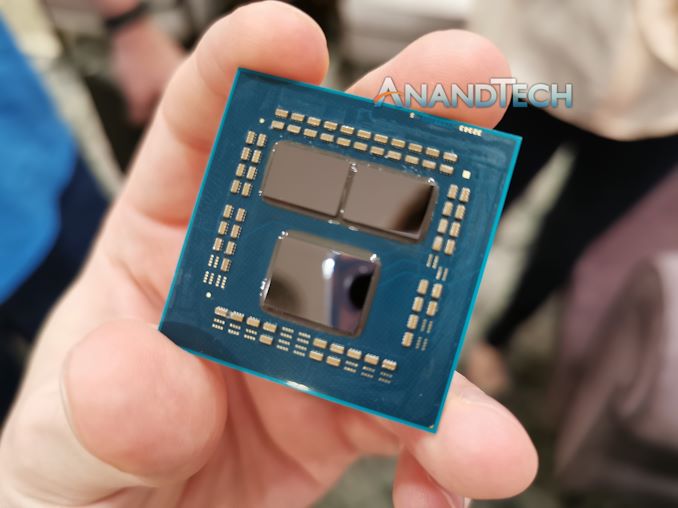Reaching for Turbo: Aligning Perception with AMD’s Frequency Metrics
by Dr. Ian Cutress on September 17, 2019 10:00 AM EST
For those that keep a close eye on consumer hardware, AMD recently has been involved in a minor uproar with some of its most vocal advocates about the newest Ryzen 3000 processors. Some users are reporting turbo frequencies much lower than advertised, and a number of conflicting AMD partner posts have generated a good deal of confusion. AMD has since posted an update identifying an issue and offering a fix, but part of all of this comes down to what turbo means and how AMD processors differ from Intel. We’ve been living on Intel’s definitions of perceived standards for over a decade, so it’s a hard nut to crack if everyone assumes there can be no deviation from what we’re used to. In this article, we’re diving at those perceived norms, to shed some light on how these processors work.
A Bit of Context
Since the launch of Zen 2 and the Ryzen 3000 series, depending on which media outlet you talk to, there has been a peak turbo issue with the new hardware. This turbo frequency issue has been permeating in the ecosystem since Zen 2 was launched, with popular outlets like Gamers Nexus noting that on certain chips, the advertised turbo frequency was only achieved under extreme cooling conditions. For other outlets, being within 50 MHz of the peak turbo frequency has been considered chip-to-chip variation, or a function of early beta firmware. A wide array of people put varying amounts of weight behind this, from conspiracy to not being bothered about it at all.
However, given recent articles by some press, as well as some excellent write-ups by Paul Alcorn over at Tom’s Hardware*, we saw that the assumed public definitions of processor performance actually differs from Intel to AMD. What we used as the default standard definitions, which are based on Intel’s definitions, are not the same under AMD, which is confusing everyone. No one likes a change to the status quo, and even with articles out there offering a great breakdown of what's going on, a lot of the general enthusiast base is still trying to catch up to all of the changes.
This confusion – and the turbo frequency discussion in general – were then brought to the fore of news in the beginning of September 2019. AMD, in a two week span, had several things happen essentially all at once.
- Popular YouTuber der8aur performed a public poll of frequency reporting that had AMD in a very bad light, with some users over 200 MHz down on turbo frequency,
- The company settled for $12.1m in a lawsuit about marketing Bulldozer CPUs,
- Intel made some seriously scathing remarks about AMD performance at a trade show,
- AMD’s Enterprise marketing being comically unaware of how its materials would be interpreted.
Combined with all of the drama that the computing industry can be known for – and the desire for an immediate explanation, even before the full facts were in – made for a historically bad week for AMD. Of course, we’ve reported on some of these issues, such as the lawsuit because they are interesting factoids to share. Others we ignored, such as (4) for a failure to see anything other than an honest mistake given how we know the individuals behind the issues, or the fact that we didn’t report on (3) because it just wasn’t worth drawing attention to it.
What has driven the discussion about peak turbo has come to head because of (1). Der8auer’s public poll, taken from a variety of users with different chips, different motherboards, different cooling solutions, different BIOS versions, still showed a real-world use case of fewer than 6% of 3900X users were able to achieve AMD’s advertised turbo frequency. Any way you slice it, without context, that number sounds bad.
Meanwhile, in between this data coming out and AMD’s eventual response, a couple of contextual discrepancies happened between AMD’s partner employees and experts in the field via forum posts. This greatly exacerbated the issue, particularly among the vocal members of the community. We’ll go into detail on those later.
AMD’s response, on September 10th, was a new version of its firmware, called AGESA 1003-ABBA. This was released along with blog post that detailed that a minor firmware issue was showing 25-50 MHz drop in turbo frequency was now fixed.
Naturally, that doesn’t help users who are down 300 MHz, but it does come down to how much the user understands how AMD’s hardware works. This article is designed to shed some light on the timeline here, as well as how to understand a few nuances of AMD's turbo tech, which are different to what the public has come to understand from Intel’s use of specific terms over the last decade.
*Paul’s articles on this topic are well worth a read:
Ryzen 3000, Not All Cores Are Created Equal
Investigating Intel’s Claims About Ryzen Reliability
Testing the Ryzen 3000 Boost BIOS Fix
This Article
In this article we will cover:
- Intel’s Definition of Turbo
- AMD’s Definition of Turbo
- Why AMD is Binning Differently to Intel, relating to Turbo and OC
- A Timeline of AMD’s Ryzen 3000 Turbo Reporting
- How to Even Detect Turbo Frequencies
- AMD's Fix











144 Comments
View All Comments
Kangal - Tuesday, September 17, 2019 - link
Yeah a Three Scenario figures sound best. It's easiest for consumers to understand. They should apply it for their GPUs and CPUs, and for all products ranging from Mobile to Server.Example:
Base Clock --- Burst Clock -- Boost Clock
3GHz 8 core - 5GHz 1 core - 4GHz 8 core
90W TDP ----- 120W TDP --- 150W TDP
teamet - Tuesday, September 17, 2019 - link
Whatever.. It's fine no matter what. It's just .. I mean .. why couldn't they just write 4.35 GHz on the box or whatever. The performance is there. No need to try and over-exaggerate clock.It feels like a battle between engineers and marketing, and marketing got to write the clock on the box in the end.
mczak - Tuesday, September 17, 2019 - link
IMHO AMD made a mistake anyway trying to extract every little bit of performance. Leave those last 3% to the overclockers - they aren't really relevant but come at the expense of quite a lot of efficiency.franzeal - Thursday, September 19, 2019 - link
So you think it's better they create an inferior product for the masses, so that a few can feel like they got something extra/free? They did good.mikato - Monday, September 23, 2019 - link
Agree. This is a step forward as long as any risks are minimal. Why leave some performance only for overclockers if you don't have to?Arnulf - Tuesday, September 17, 2019 - link
This is an industry-wide thing (have a look at the mobile SoCs, e. g. Qualcomm, ...). They love rounding their frequency figures up, reality be damned!DroidTomTom - Tuesday, September 17, 2019 - link
Reminds me of the days of the AMD Athlon XP 2500+ Barton 1.833 GHz Socket A CPU's. They were faster IPC than Intel but people only paid attention to frequency which was misleading. AMD was trying to put the focus on overall performance per dollar.Dribble - Tuesday, September 17, 2019 - link
The graphs on pages 2 and 3 tell you all you need to know. AMD just run there cpu's far to close to the limit and give you numbers that are higher then what is understood by boost (it would be like Intel advertising boost as 5.2 not 4.6).It's deceptive really as the number does not mean the same thing as Intel's number. I am sure I'll get 20 replies saying how this is fine, but if it were Intel doing this then I bet the same people would be roasting Intel for this sort of miss-information.
Karmena - Wednesday, September 18, 2019 - link
first, AMD does not call it Turbo, like Intel does. It is Boost. The problem is you assuming that those are the same. Same as in legal speak, you have to go and look up the definition of what is claimed. Or keep every company accountable. As most of the time they add that trademark thingy, and in the end that just means that the company gets to set up the definition of what it is. SMT vs HT.Spunjji - Monday, September 23, 2019 - link
I can't believe anyone would make it all the way through such an informative article like this and then still post such an ignorant comment. The only reasonable conclusion is that you did not take the time to read it properly, because everything you said was discussed at length.